On May 1, 2000, NEAR Shoemaker spacecraft took pictures of the EROS asteroid, and one of them was published as the "Image of the Day" for May 3, 2000, at:
http://near.jhuapl.edu/iod/20000503/index.html
A TIF version of the same image can be viewed there; it does not comprise the slight deformations and artifacts of the JPG version shown directly on the page. The NEAR Shoemaker images of EROS are grey-scale images with a maximum of 256 grey levels. The page is an original page by the NEAR Shoemaker satellite science team; there is no need to question its authenticity.
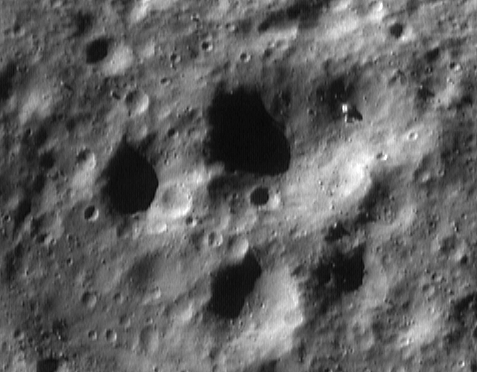
|
Image 0132577092 is captioned on the "Image of the Day" web page:
"This image of Eros, taken from the NEAR Shoemaker spacecraft on May 1, 2000, is among the first to be returned from 'low orbit.' Between May and August, the spacecraft will orbit at altitudes near 50 kilometers (31 miles) or less. This will be the prime period of activity for some of the spacecraft's science instruments. The X-ray / gamma-ray spectrometer will build up maps of chemical abundances, while the laser rangefinder measures the shape of Eros to within meters (a few feet). At the same time the magnetometer will watch for indications of Eros' magnetic field and the near-infrared spectrometer will map rock types."
"The imager will take pictures of the entire surface of Eros that capture features as small as 4 meters (13 feet) across. This particular image, taken from an orbital altitude of 53 kilometers (33 miles), shows a scene about 1.8 kilometers (1.1 miles) across. Numerous craters and boulders as small as 8 meters (26 feet) across dot the landscape. The large, rectangular boulder at the upper right is 45 meters (148 feet) across."
The caption of the image gives the opinion of the publishers: the image contains a "large, rectangular boulder".
Because it looks rectangular, some UFO websites and ufologists decided that it cannot be a boulder, and they suggest or claim that it must be something artificial, or artificial and extraterrestrial.
Maybe it is. Maybe it is a spacecraft of alien origin, or some device or artificial construction of extraterrestrial origin.
But I need to explain something very important about such images.
The image has a certain resolution. The image is made of "pixels", picture elements, each one showing the average light reflected on the square area of the pixel.
When "zooming in" on the image, or "enlarging" the image, there are two methods that can be used.
One method is to show the pixels with a larger size than their original size. Take the pixels in the image, look at its color, and make bigger squares of the pixels, keeping each pixel color and position. You get a larger image that remains faithful to the original image. This is the only valid method.
This is what you get with the "boulder" or "thing" in the original image, using a 10 times enlargement factor:
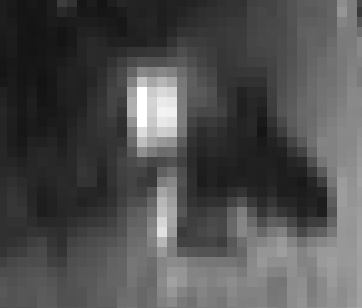
|
Of course it does not look very "nice". The small pixels become larger squares. No detail is added, no deformation generated, no extra information is added. It is not "nice", but it is faithful to the original image.
Unfortunately, some ufologists or mystery mongers do not use this method. They use smoothing. Smoothing is intended to make a "nicer" enlargement of the image. Additional pixels are interpolated so that the image does not look like just larger pixels. Of course it looks "nicer", but in reality, it is not a faithful rendition of the information originally in the image. It created the illusion that the original image has more to offer than it really has. It creates the false impression that more details were in the original image than there really was.
Some people do not even realize this. They use some software to zoom at the image without realizing that the software automatically smoothes the original pixels when they zoom in or enlarge the image. Maybe some others know about the problem, but they choose to fool their readers. They do not tell you that the image was smoothed, they do not show you what a faithful enlargement or smoothing would show you, because it would make you realize that the few pixels do not provide a detailed image but only a "disappointing" image and you would realize that a better image would be necessary to really decide whether the "thing" is just a roughly "rectangular" boulder or something really more interesting.
Most imaging software let you choose how the enlargement or zooming should be done. For example, the old Paint Shop Pro has these settings in its image enlargement menu:

|
"Pixel resize" is the enlargement mode that does not alter the information in the image. The other modes use various smoothing techniques. And many imaging software do a smoothing operation by default when the zoom is used, not asking the user whether he wanted this or not.
So, those claiming the "thing" is something much more striking than a boulder could show you the image below on the left, but they prefer to show you an image such as below on the right, in which I used smoothing:

Enlarged 10x no smoothing. |
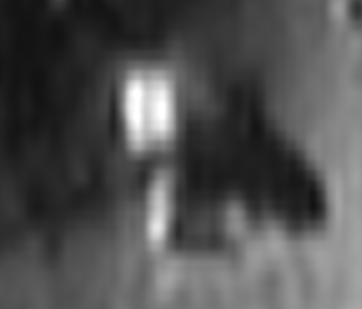
Enlarged 10x with slight smoothing. |
This is how the image is shown on one UFO website claiming it is something of intelligent extraterrestrial nature:
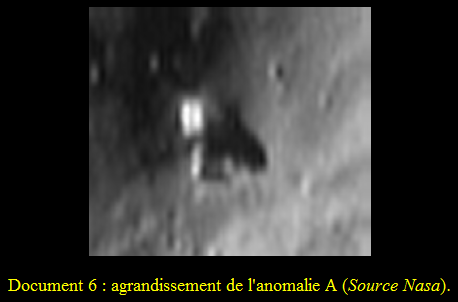
|
Of course smoothing was used, and of course the image source is not really NASA, the caption by this UFO website is misleading. The image that really is from NASA is this one, and the enlargement above is in no way done by NASA folks, but a smoothed-down version by the author of the UFO web article:

|
The naive or misleading author displayed the "thing" using smoothing alteration; but this is not all. He will also interpret what is left of some single pixel as a real square feature. But it isn't! It looks like a square because the pixel is a square, nothing permits to deduce that a real square was there. Look at this interpretation made on a UFO website:
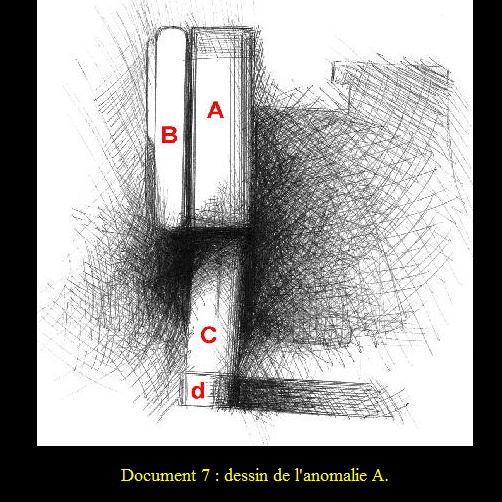
|
See the feature marked "D" in the above sketch? See how a square was sketched there?
Well, this is not a real square feature, but just this square pixel:
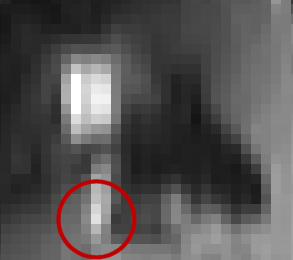
|
Whether by lack of competence in imaging, or to voluntarily trick you, a number of ufologist use the same process when they enlarge UFO images, something often done with what is now called BLURFO images.
So, never believe any enlarged image to be a faithful image. Whenever possible, look for the original image, do a correct pixel enlargement if you must, without something, and only then, decide whether there is or isn't sufficient information in the image to assess what it shows with any certainty.
The NEAR Shoemaker team says the "thing" is a boulder. Some say it's not. How can this be decided? There will not be any better image of the "thing" very soon, but the NEAR Shoemaker team shows many more pictures of EROS. For example, this one:
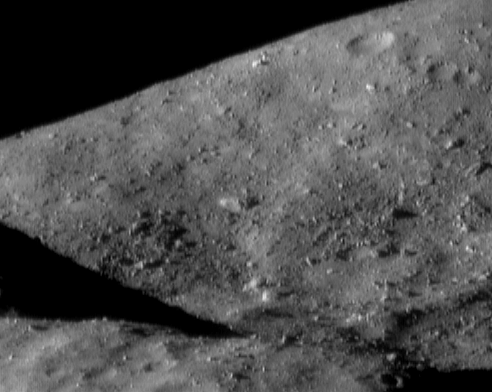
|
Source: http://near.jhuapl.edu/iod/20001229/20001229.tif
What we see here is that "things" that look like the "rectangular thing" are not exceptional. Here, several "things" appear, with a similarly bright albedo:

|
Source: http://near.jhuapl.edu/iod/20010102/20010102.tif
Here, the image was closer to the surface, and we see it is littered with boulders, probably not spaceship or artifact:
I guess that several features in this image would have been called "anomaly" if they had been more isolated from the others.
Something else strikes me in the "anomaly" image:
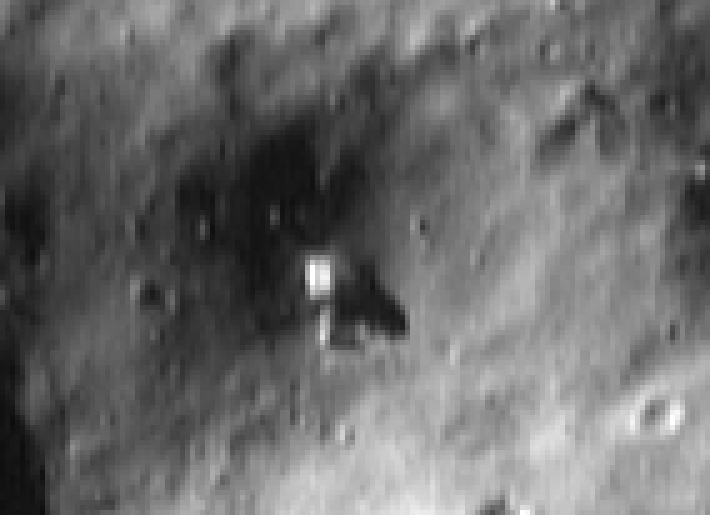
|
The "thing" looks elongated. This adds to its somehow "unnatural" look, as expectedly boulders would generally not be very elongated but rather roughly round. But in the same image, other "things" look elongated too. In facts, it seems as if any small feature, every boulder, is elongated. So I guess the "elongated" aspect may have been caused by movement of the space probe during the shot of the image:
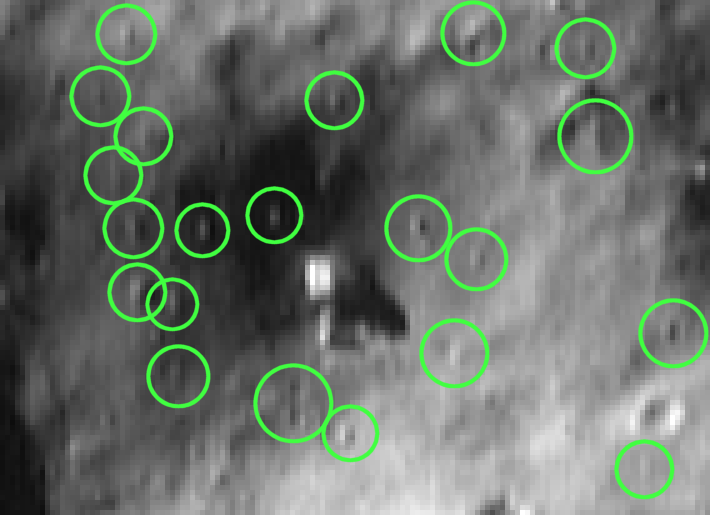
|
When I look at other pictures, I see that the background too is more blurry in this one than the other; this would confirm camera move as the cause of the elongation and the "rectangular", unnatural aspect.
So, the "thing" that some people strongly believe to be something else than a boulder is likely really a boulder. And in any case, while its image does not offer enough detail to decide for sure, people should stop to use smoothed enlargements of such images or UFO images.
Some of the UFO websites showing invalid enlargement and claiming the "thing" is not a boulder:
The NEAR Shoemaker website: